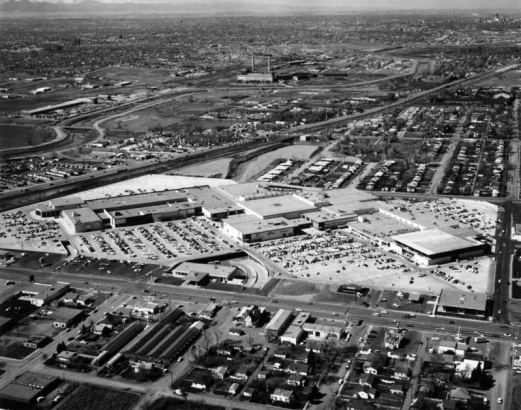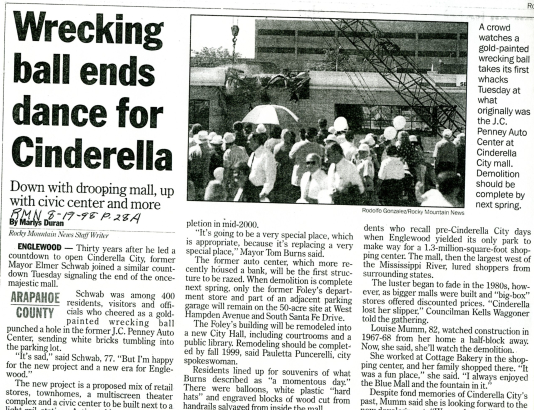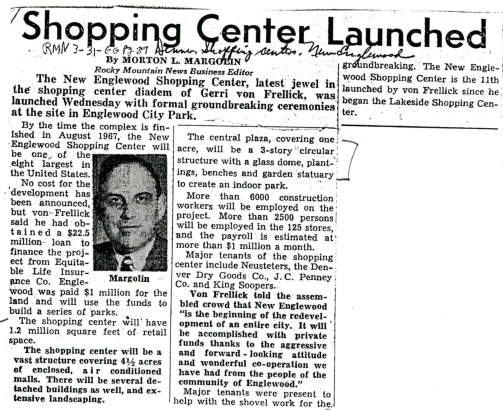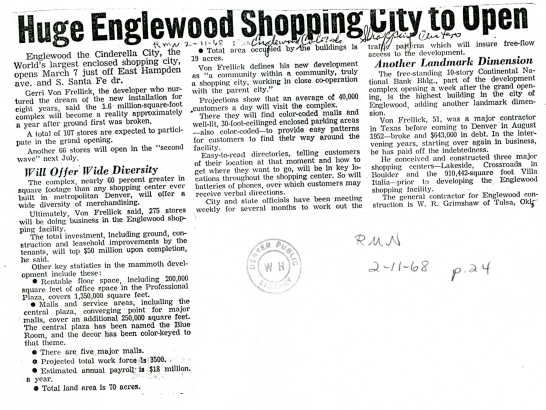On March 7, 1968, the doors swung open on Cinderella City—a mall that was unlike any shopping center the Denver area had ever seen. On opening day, the new mall boasted more than 1.5 million square feet of space spread across five distinct malls that covered about two miles. It featured 7,000 parking spaces, the promise of more than 250 retailers and an exquisite fountain.
According to its builders, it was the largest indoor shopping center in the world on that spring morning. (Though mostly it would be referred to as, "the largest mall west of the Mississippi.")
Local shoppers went absolutely nuts for the fairy tale shopping space. For decades, it was the place to shop in the Denver area, and customers streamed in from across the Mountain West.
By 1997, however, the clock struck midnight as the employees of Montgomery Ward, the mall's last major retailer, closed its doors for the final time.
The rise and fall of Cinderella City is a story that includes huge helpings of economic postwar optimism, the brutal realities of retail marketing and plenty of nostalgia.
Bringing Cinderella City to Life
In 1960, Gerri Von Frellick was the king of Denver shopping centers. He had already spearheaded the development of the Villa Italia in Lakewood, which would open in 1962, but was itching for a project that was substantially larger.
That's why he approached the Englewood City Council with an idea that was as risky as it was visionary. Von Frellick wanted to purchase a 55-acre lot near the Englewood City Hall, which had once housed the KLZ radio transmitters, and redevelop it into something the likes of which Denver had never seen.
His project even had a glamorous code name, Cinderella City.
Like the ideas of so many visionaries before him, Von Frellick's plan was met with no small amount of friction. Many locals, including those in Cherry Hills Village, were not happy about the prospect of living near the world's largest shopping center, and the Englewood City Council wasn't crazy about the name. In fact, at various points throughout the mall's early development, Englewood lawmakers openly offered Von Frellick small concessions if he changed the name.
During the early planning stages, in November 1962, the Englewood City Council killed the project entirely. In a 5-2 vote, the Council denied the zoning changes that were required to bring the mall to life. There were, in fact, five votes in favor of the mall, but a two-thirds majority was required for zoning decisions.
A Rocky Mountain News article from November 11, 1962, explained the opposition as stated by attorney Harold Feter saying, "Residents seeking to protect zoning integrity of the area were generally against the shopping center proposal."
After a few courtroom battles, Von Frellick and company finally gained approval for their ambitious plan.
As for the name, Von Frellick claimed that it was just a placeholder. For reasons that appear to be unexplained, he kept the name anyway.
With the challenges of fighting/working with City Hall behind him, Von Frellick was all set to move Cinderella City from dream to reality.
(Cinderella City's move from dream to reality is a subject that's practically worthy of a book-length treatment and falls far beyond the parameters of a single blog post. For more information on this subject, see the scanned news articles in the attached Remembering Cinderella City gallery.)
Shovel Ready
Compared to the challenges of actually receiving permission to build, the construction of Cinderella City was relatively uneventful.
On March 31, 1966, according to the Rocky Mountain News, Von Frellick presided over the groundbreaking of what the paper referred to as, "The New Englewood Shopping Centre." At that time, Von Frellick promised a development that would hire more than 2,500 employees, boast 250 stores and possess a monthly payroll of more than $1 million.
Two years later, on March 7, 1968, the mall was ready to open and was on course to radically alter the shape of retail shopping in the Denver area.
To say that expectations were high on that morning is an understatement. An article in the Rocky Mountain News even suggested as many as 1 million people might visit the mall during its first three days of operations, and both the News and the Denver Post featured special Cinderella City sections. Given that the population of the entire Denver metro area was only around 1.2 million at the time, the Rocky Mountain News's estimate seemed hugely optimistic.
Even so, Cinderella City's opening weekend and its subsequent decades in operation were nothing short of a spectacular success.
(What happened when Cinderella City finally opened its doors to starstruck Colorado shoppers? Find out in Part 2 of "Cinderella City: The Decline and Fall of Colorado's Most Memorable Mall.")







Comments
Exactly right. The golf
Exactly right. The golf course is on the landfill but I do believe Cinderella City was built on an old river bed which gave it the structural issues.
HI Brett - You're right on
HI Brett - You're right on the money. We're working on another article for the future that covers exactly that topic. Thanks for bringing it up!
No land fill. Built on a 4
No land fill. Built on a 4 baseball field and swiming pool and park to the north with slopeing terrain to the north. It was built witb undermain level parking so the upper parking was all elevated. Lots of bad mouthing about construction. The upper level was like an ocean in spots but I never heard of it caving in. It was mesmerizing when it opened. The smell, the fountain the enormity of it all. It was the bomb.
Hi Mike - Cinderella City was
Hi Mike - Cinderella City was, indeed, the bomb. It was my impression that the parking garage was sinking, not collapsing. A subtle difference (but you sure wouldn't want either one to happen to a parking garage!). Thanks for reading!
Interesting that the
Interesting that the originally proposed site was Hampden and University, butting up to Cherry Hills. No wonder it was fought by residents and voted down by the city.
Brian-Was the article,in the
Brian-Was the article,in the Photo Gallery, correct on Cinderella City being proposed for Hampden and University?
Brian-Was the article,in the
Brian-Was the article,in the Photo Gallery, correct on Cinderella City being proposed for Hampden and University?
It's my understanding (thanks
It's my understanding (thanks to one of our readers who e-mailed me) that was the original site. Parsing out the context of those early articles was a bit of a challenge!
Kent School was on the corner
Kent School was on the corner of Hampden and University and that site was taken over by another school (Denver Seminary) when Kent moved to the current location. Cinderella City was proposed where the KLZ towers were on Hampden and Gilpin. I grew up on Gilpin and remember the towers and the fight to move Cinderella City to another location. The structural engineer for Cinderella City was Bill Sallada and he made a few miscalculations!
Hi Tami - That site is
Hi Tami - That site is actually where the KLZ towers were. (We'll be correcting that.) Thanks for the great comment!
Add new comment